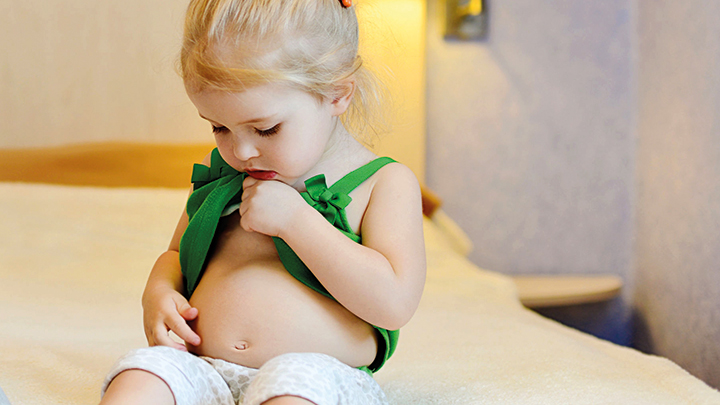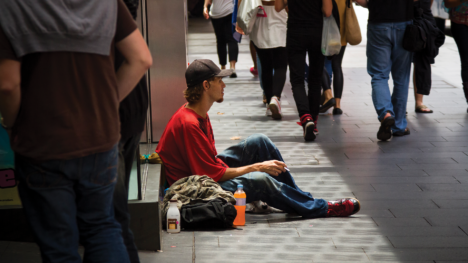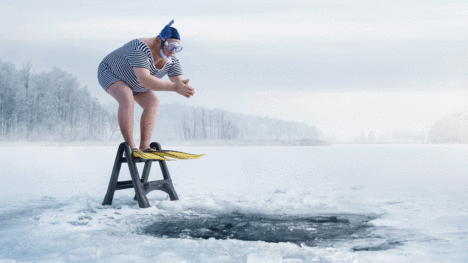Beyond size
October 1, 2017

It was six o’clock in the evening, bath time, and my two-and-a-half-year-old daughter was standing in front of me wearing only her socks. She was, as one would expect of a toddler, not in the least ashamed of her body as she proudly patted her belly.
“Look at my tummy!” she said, sticking it out as far as it would go. “Look how big it is!” She grinned at me expectantly.
“It’s not big!” I exclaimed, as if that would be a bad thing. “It’s thin, and beautiful!”
And there it was. The moment I realised I’d failed as a mother.
I, who had vowed to embrace all body shapes and sizes, who had ditched the scales as soon as I became pregnant, who had sworn never to say the four-letter word diet in front of my daughter, was sending her a message that I should judge her body by its size.
My goal was to be a positive role model for my daughter. I wanted her to realise that she was beautiful just as she was. But this was hard, given that I was embarrassed about my own body. I felt like I fell short of some idealised notion of what was attractive in other people’s eyes, so I went on diets and attended gym classes, all under the guise of so-called “self-improvement”.
But why, as a mature adult, should I be embarrassed about my body? Why did I believe that my body was somehow fundamentally flawed?
Psychologically speaking
Psychologists, counsellors and exercise physiologists agree that body image—the way we view our bodies and the assumptions we make about how others view our bodies—is a complex issue that begins in childhood.
“The most important relationship we have is the one we have with ourselves,” says relationships counsellor and psychotherapist Charmaine Roth. “From a very early age, we hear messages from our parents and other adults about how we should look and behave. As we grow older, these messages are reinforced by the images we see in the media. All of these messages, put together, reinforce unrealistic expectations about our appearance.”
Most of us understand that media images are manipulated. Ideally, publishers would provide readers with information about digitally altered images. “Creating unrealistic expectations about what is a ‘healthy’ or ‘ideal’ body shape could lead to the risk of adverse effects on the physical or mental health of readers,” says Professor David Weisbrot, who previously chaired the Australian Press Council.
Jennifer Beveridge, from the Eating Disorders Foundation of Victoria, agrees that exposure to unrealistic images in the media can contribute to a negative body image. “Heavily photoshopped advertising campaigns using models that lack diversity send a message that only one type of body can be considered beautiful,” she says.
But the problem is a lot deeper than photoshopping, and no generation is exempt. I grew up in the eighties, at a time when Barbie was asserting her independence. As a young girl I admired her ability to be a surgeon, an astronaut and a racing car driver. But I also admired her long skinny legs and tiny waist and viewed them as a prerequisite to being a successful woman. This is despite an analysis by the University Central Hospital in Finland, which estimated that she lacked the 17 per cent minimum body fat required to menstruate!
And as for my mother, who was a teenager in the 1960s, one of the most famous women in the world at that time was English model and actress Lesley Lawson, aka Twiggy, voted British Woman of the Year in 1966. Her very name described her figure and reflected society’s worship of thinness.
"The most important relationship is the one we have with ourselves."
Thankfully, our dress size or how we wear our hair doesn’t dictate our actual survival. But the fact remains that humans have, as clinical psychologist Sam Van Meurs notes, always admired beauty and perfection, something that is only exacerbated by the highly visual society in which we live. “We are more aware of our physical selves than ever before due to the ever present social comparisons that we make on social media and when we see advertising,” he says.
Physiotherapist Nikhil Taneja agrees. She has seen many young women try to emulate celebrities. “They come to me because they want to know if yoga or Pilates will give them the same kind of physique as the celebrities they follow. When I try to explain to them that these celebrities also go on extreme diets, many of them don’t come back.”
Practically speaking . . .
Research indicates that eating disorders are on the increase, and it’s clear that perceiving our body in a negative light can have serious repercussions on our health. So what steps can you take to develop a healthier body image?
“Focusing less on what your body looks like and more on what it can do is a good first step,” says Beveridge. “Emphasise your inner strengths and value things unrelated to your physical appearance. Cut out negative self-talk, and engage in plenty of self-care.”
Health and community psychologist Dr Marny Lishman agrees that we need to stop putting ourselves down. “When we are self-accepting, we embrace all the parts of ourselves, our strengths and our weaknesses, the good and the bad,” she says.
When it comes to our children, there are many things we can do to encourage a positive body image, says Charmaine Roth. “Encourage mealtimes to be a time when the family can sit together and talk, rather than it being too focused on food,” she says.
Other strategies she advises we employ include taking care with the language we use, maintaining a healthy attitude toward diet and exercise, and praising our children’s strengths and abilities rather than their appearance.
As for me, I did my best to reduce my negative self-beliefs. I began to focus on my strengths, and I worked on accepting my feelings. In the end, though, the most powerful lesson came from home. It was my daughter’s bath time again, and I’d gotten into the tub with her to tackle the challenging task. After the shampooing, detangling, washing, rinsing and obligatory bath toy games, we were back on the bath mat, drying ourselves off with towels.
“Mummy,” my daughter said, looking up at my body with a bright glow on her cheeks. “We’re the same.”
In that moment I suddenly realised something: my daughter, with the innocent eyes of a young child, could look at my body and see that our similarities were more important than our obvious differences.
I knelt down in front of her and put my hands on her shoulders. I could feel the outline of her bones and the soft slope of her arms.
“We are the same,” I reassured her, “and we are beautiful.”
And even though I’d been telling myself to love my body, for the first time in my life I truly meant it.









